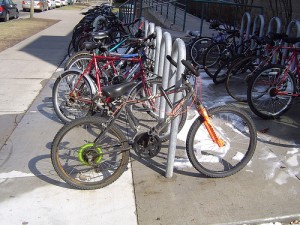Incentivizing the School Commute
 Photo: Mat_the_W
Photo: Mat_the_WWe’ve written about bribing kids to get better grades. But what about bribing them to walk or ride their bike to school?
A new working paper examines a program in Boulder, Colorado that attempted to incentivize kids to bike or walk to school over a span of several years. The program began with a $10 cash prize for the first two years, but then switched over to a $10 bike store coupon thereafter. One lucky student who rode and walked to school every day during a “prize period” won the coupon.
Even considering the small, non-cash winnings, biking and walking to school increased 16 percent during the prize period. Here’s the abstract:
We analyze the effects of a school-based incentive program on children’s exercise habits. The program offers children an opportunity to win prizes if they walk or bike to school during prize periods. We use daily child-level data and individual fixed effects models to measure the impact of the prizes by comparing behavior during prize periods with behavior during non-prize periods. Variation in the timing of prize periods across different schools allows us to estimate models with calendar-date fixed effects to control for day-specific attributes, such as weather and proximity to holidays. On average, we find that being in a prize period increases riding behavior by sixteen percent, a large impact given that the prize value is just six cents per participating student. We also find that winning a prize lottery has a positive impact on ridership over subsequent weeks; consider heterogeneity across prize type, gender, age, and calendar month; and explore differential effects on the intensive versus extensive margins.
This bump in exercise is significant, especially considering the overall downturn in children walking to school at all. From 1969 to 2001, the percentage of self-commuters dropped from 41 percent to 13 percent. In his recent article pointing this out, Freakonomics contributor Eric Morris ended on an inquisitive note:
“So the next question is, what factors cause kids to walk and bike? And how can we use that information to promote active travel?”
In the Boulder experiment, children who won the lottery were excluded from winning future lotteries, but remained actively commuting to school for the next two weeks. After this, however, they went back to normal. Problematically, the 16 percent increase in walking and biking did not exist during non-prize-periods. But this study, at least in part, offers the beginning of an answer.

Comments